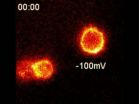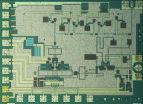(Press-News.org) (SACRAMENTO, Calif.) — Researchers have created a cellular probe that combines a tarantula toxin with a fluorescent compound to help scientists observe electrical activity in neurons and other cells. The probe binds to a voltage-activated potassium ion channel subtype, lighting up when the channel is turned off and dimming when it is activated.
This is the first time researchers have been able to visually observe these electrical signaling proteins turn on without genetic modification. These visualization tools are prototypes of probes that could some day help researchers better understand the ion channel dysfunctions that lead to epilepsy, cardiac arrhythmias and other conditions.
The study appears in the Proceedings of the National Academy of Sciences (PNAS) on October 20.
"Ion channels have been called life's transistors because they act like switches, generating electrical feedback" said senior author Jon Sack, assistant professor of physiology and membrane biology at UC Davis.
"To understand how neural systems or the heart works, we need to know which switches are activated. These probes tell us when certain switches turn on," he said.
Voltage-gated channels are proteins that allow specific ions, such as potassium or calcium, to flow in and out of cells. They perform a critical function, generating an electrical current in neurons, muscles and other cells. There are many different types, including more than 40 potassium channels. Though other methods can very precisely measure electrical activity in a cell, it has been difficult to differentiate which specific channels are turning on.
"There are about 40 voltage-gated potassium channel genes that are basically doing the same thing, and it's been shockingly hard to figure out which ones are doing something that's physiologically relevant," Sack said.
The tarantula toxin, guangxitoxin-1E, was an ideal choice because it naturally binds to the Kv2 channels. These channels are expressed in most, if not all, neurons, yet their regulation and activity are complex and actively debated. Sack and his laboratory worked closely with Bruce Cohen, a scientist in the Lawrence Berkeley Lab's Molecular Foundry, who has been studying how fluorescent molecules and nanoparticles can be used to image live cells.
To study the channels, the team engineered variants of tarantula toxin that could be fluorescently labeled and retain function. These probes were designed to bind to the potassium channels when they were at rest and let go when they became active. The researchers then tested them on living cells. To their surprise, the probes worked right away.
"A lot of times you see ambiguous results, but when we added the probes to living cells there was a very clear signal," Sack said. "When we added potassium to stimulate the cells, the probes fell right off."
While this is just a first step towards imaging the activity of potassium and possibly other ion channels, this approach holds vast potential to help scientists understand the underlying mechanisms behind cardiac arrhythmias, muscle defects and other channelopathies.
"There are dozens of known channelopathies, and more being uncovered at an increasing pace" Sack said. "If you have electrical signaling, you have to have a potassium channel, and when that channel goes bad, the cell doesn't work the same anymore. For example, the Kv2.1 channel that this probe binds to leads to epilepsy when it's not functioning properly."
In addition, the ability to better observe electrical signaling could help researchers map the brain at its most basic levels.
"Understanding the molecular mechanisms of neuronal firing is a fundamental problem in unraveling the complexities of brain function," Cohen said.
While creating a probe that can read whether the Kv2.1 channel is firing or at rest is an important proof-of-concept, there's still a lot of work to be done. Sack and Cohen will continue to collaborate, testing other types of spider venoms that bind to different potassium channels.
VIDEO:
The video shows the imaging capabilities of the fluorescent tarantula toxin probe to observe the Kv2 potassium ion channels 'turning on' in live nerve cells. The cell on the left...
Click here for more information.
"The beauty of this is the potential," Sack said. "This is a toehold into a new way of visualizing electrical activity, and there's a huge family of spider toxins that target different ion channels. We've tagged a Ford, we should be able to tag a Chevy."
INFORMATION:
The researchers who conducted this study include: Drew C. Tilley, Kenneth S. Eum, Sebastian Fletcher-Taylor, Daniel C. Austin and Vladimir Yarov-Yarovoy of the Department of Physiology and Membrane Biology at UC Davis; Christophe Dupré and Lilian Patrón, Neurobiology Course, Marine Biological Laboratory, Woods Hole; Rita L. Garcia, Molecular Foundry, Lawrence Berkeley National Laboratory; and Kit Lam, Department of Biochemistry and Molecular Medicine at UC Davis.
This project was funded by: NIH grants 5P30GM092328-02, R01NS042225-09S1, R25NS063307, T32HL086350; AHA grant 10SDG4220047; and the Milton L. Shifman Endowed Scholarship for the Neurobiology Course at Woods Hole. Work at the Molecular Foundry was supported by the Office of Science, Office of Basic Energy Sciences, of the U.S. Department of Energy under Contract DE-AC02-05CH11231.
Some people suffer incipient dementia as they get older. To make up for this loss, the brain's cognitive reserve is put to the test. Researchers from the University of Santiago de Compostela have studied what factors can help to improve this ability and they conclude that having a higher level of vocabulary is one such factor.
'Cognitive reserve' is the name given to the brain's capacity to compensate for the loss of its functions. This reserve cannot be measured directly; rather, it is calculated through indicators believed to increase this capacity.
A research project ...
Scientists from Queen's University Belfast have been involved in a groundbreaking discovery in the area of experimental physics that has implications for understanding how radiotherapy kills cancer cells, among other things.
Dr Jason Greenwood from Queen's Centre for Plasma Physics collaborated with academics from Italy and Spain on the work on electrons, which has been published in the international journal Science.
Using some of the shortest laser pulses in the world, the researchers used strobe lighting to track the ultra-fast movement of the electrons within a nanometer-sized ...
A new study led by researchers at King's College London in collaboration with the University of Manchester and the University of Dundee has found a strong link between exposure to peanut protein in household dust during infancy and the development of peanut allergy in children genetically predisposed to a skin barrier defect.
Around 2% of school children in the UK and the US are allergic to peanuts. Severe eczema in early infancy has been linked to food allergies, particularly peanut allergy. A major break-through in the understanding of eczema developed with the discovery ...
Fewer cords, smaller antennas and quicker video transmission. This may be the result of a new type of microwave circuit that was designed at Chalmers University of Technology. The research team behind the circuits currently holds an attention-grabbing record. Tomorrow the results will be presented at a conference in San Diego.
Every time we watch a film clip on our phone or tablet, an entire chain of advanced technology is involved. In order for the film to start playing in an even sequence when we press the play button, the data must reach us quickly via a long series ...
An experimental drug currently being trialled for influenza and Ebola viruses could have a new target: norovirus, often known as the winter vomiting virus. A team of researchers at the University of Cambridge has shown that the drug, favipiravir, is effective at reducing – and in some cases eliminating – norovirus infection in mice.
Norovirus is the most common cause of gastroenteritis in the UK. For most people, infection causes an unpleasant but relatively short-lived case of vomiting and diarrhoea, but chronic infection can cause major health problems for ...
Amsterdam, October 21, 2014 – Flu vaccines are known to have a protective effect against heart disease, reducing the risk of a heart attack. For the first time, this research, published in Vaccine, reveals the molecular mechanism that underpins this phenomenon. The scientists behind the study say it could be harnessed to prevent heart disease directly.
Heart disease is the leading cause of death worldwide. People can reduce their risk of heart disease by eating healthily, exercising and stopping smoking. However, to date there is no vaccine against heart disease.
Previous ...
Cosmologists have made the most sensitive and precise measurements yet of the polarization of the cosmic microwave background.
The report, published October 20 in the Astrophysical Journal, marks an early success for POLARBEAR, a collaboration of more than 70 scientists using a telescope high in Chile's Atacama desert designed to capture the universe's oldest light.
"It's a really important milestone," said Kam Arnold, the corresponding author of the report who has been working on the instrument for a decade. "We're in a new regime of more powerful, precision cosmology." ...
The extinction in the wild of the southern white rhino population could be prevented by letting local communities take responsibility of the animals and giving them permission to harvest horns in a controlled manner through a legal trade. Rhino horn is made of the same material as human hair and fingernails and grows back in 2–3 years.
In 2013, more than 1000 rhinos were killed illegally for their horns in South Africa. Rhino horns are being used in Asia for traditional Chinese medicine and personal prestige. Now, a new study based on ecological and socio-economic ...
NASA's newest orbiter at Mars, MAVEN, took precautions to avoid harm from a dust-spewing comet that flew near Mars today and is studying the flyby's effects on the Red Planet's atmosphere.
The MAVEN spacecraft -- full name Mars Atmosphere and Volatile Evolution -- reported back to Earth in good health after about three hours of precautions against a possible collision with high-velocity dust particles released by comet C/2013 A1 Siding Spring.
"We're glad the spacecraft came through, we're excited to complete our observations of how the comet affects Mars, and we're ...
October 20, 2014 – (BRONX, NY) – Rates of depression and anxiety vary widely among different segments of the U.S. Hispanic and Latino population, with the highest prevalence of depressive symptoms in Puerto Ricans, according to a new report from Albert Einstein College of Medicine of Yeshiva University and the Hispanic Community Health Study/Study of Latinos (HCHS/SOL). The researchers' findings also suggest that depression and anxiety may be undertreated among Hispanics and Latinos, particularly if they are uninsured. The study was published online in Annals ...





